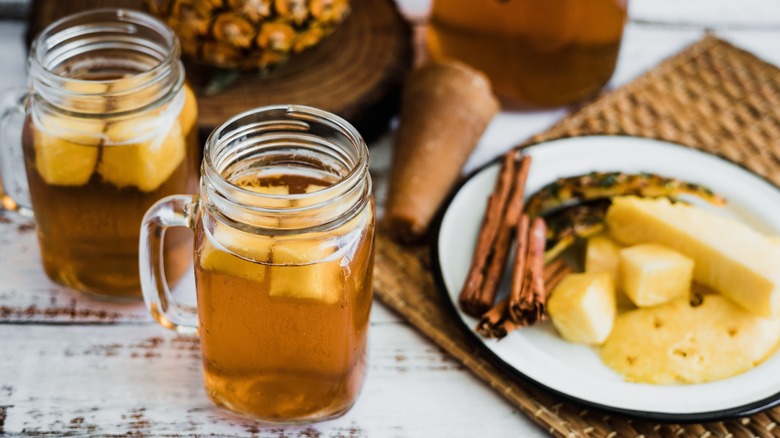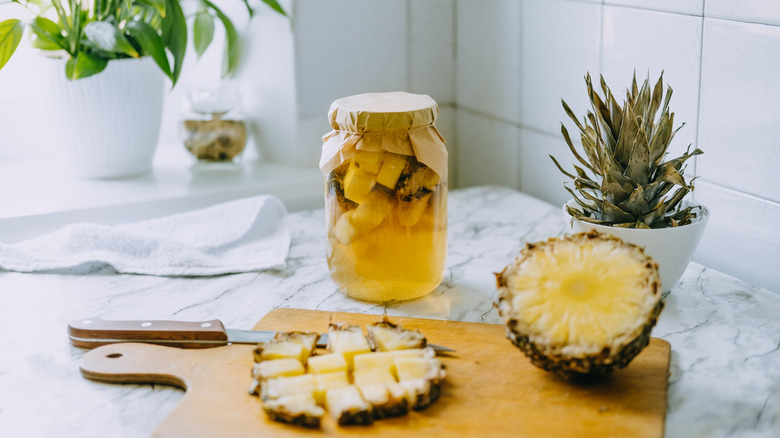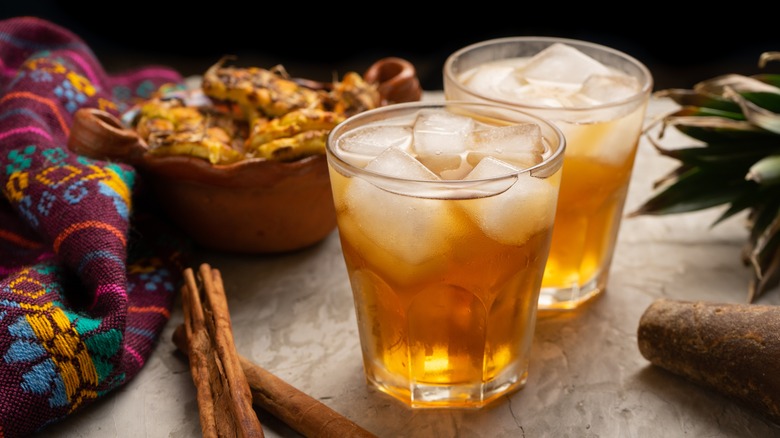What Is Tepache And How Is It Typically Served?
If you've ever cut up a whole pineapple, you may have been struck by how much of it ends up as compost (at best). The thick, prickly rind isn't exactly begging to be eaten, but it might still feel like a significant volume of the fruit just goes to waste. Fortunately, there's one word that will turn you into a zero-waste domestic maven: Tepache.
If you like pineapple, you need to be aware of tepache, a fermented pineapple drink that originated centuries ago in central Mexico. Commercially produced tepache exists today, but most of the fruity drink's history has taken place in home kitchens, with cold, home-brewed tepache providing much relief on hot days. And like most fermented drinks, it packs a wallop of flavor, coming not only from the pineapple but from added spices like cinnamon, too.
As a result of the mild fermentation, tepache typically contains a very low amount of alcohol, although boozier versions do exist. If you're curious about what pineapple-based alcohol tastes like, it's definitely worth trying — and fortunately, these days, you have the option of buying it or making it yourself.
A pineapple a day
The word "tepache" comes from "tepiātl," a word meaning "corn drink" in the ancient indigenous language Nahuatl, which was spoken by the Aztec and Mayan societies. It's believed that tepache was originally made from maize, but the recipe later evolved to be pineapple-based. In any case, the fizzy, sweet, tangy drink has been a staple of Mexico since well before European colonization.
Historically, tepache would be made in and enjoyed from clay pots. It's made by creating a mixture of pineapple rind, water, piloncillo (a kind of unprocessed brown sugar common in Mexican cuisine), and often cinnamon or other spices like clove and aniseed, then letting this mixture sit for a couple of days to ferment, and finally straining out the solids. The resulting product is typically just 2-3% alcohol by volume, less than a light beer — but some folks will actually add beer to the fermenting mixture to accelerate the process and achieve a higher ABV.
For centuries, tepache was mostly made by eye, and recipes were passed down orally, although today you can find several tutorials online for making your own tepache with specific measurements and information on the fermentation process. You can even go off script and try adding other fruits and spices, like lime or black pepper — something Mexican homebrewers have been doing for centuries.
Fresh and fizzy
If you've never had tepache, the closest comparison we can make is probably to kombucha, the drink made from fermented tea rather than fermented pineapple. Both are mildly carbonated, tangy, and a little funky with some mild sweetness, and both typically contain a very small amount of alcohol, although nonalcoholic and higher-ABV versions exist of both kombucha and tepache.
Tepache is served chilled (it is a hot weather refreshment, after all), sometimes diluted with water to mellow out the flavor. In Mexico, it's commonly sold by street vendors in plastic bags tied around with straws for easy travel, though in the U.S. today you can find both alcoholic and nonalcoholic tepache in some stores.
Though tepache is a complete drink on its own, it also lends itself well to cocktails, particularly those made with mezcal or rum. Try swapping it into any kombucha cocktail recipe for a juicy, pineapple-y twist — or just spike it with a shot of your chosen liquor and maybe dress it up with some club soda and bitters. Even if you usually avoid pineapple for its mouth-burning sourness, know that tepache is tangy but the acidity is rounded out by fermentation and the other ingredients. It's definitely worth a sip.


